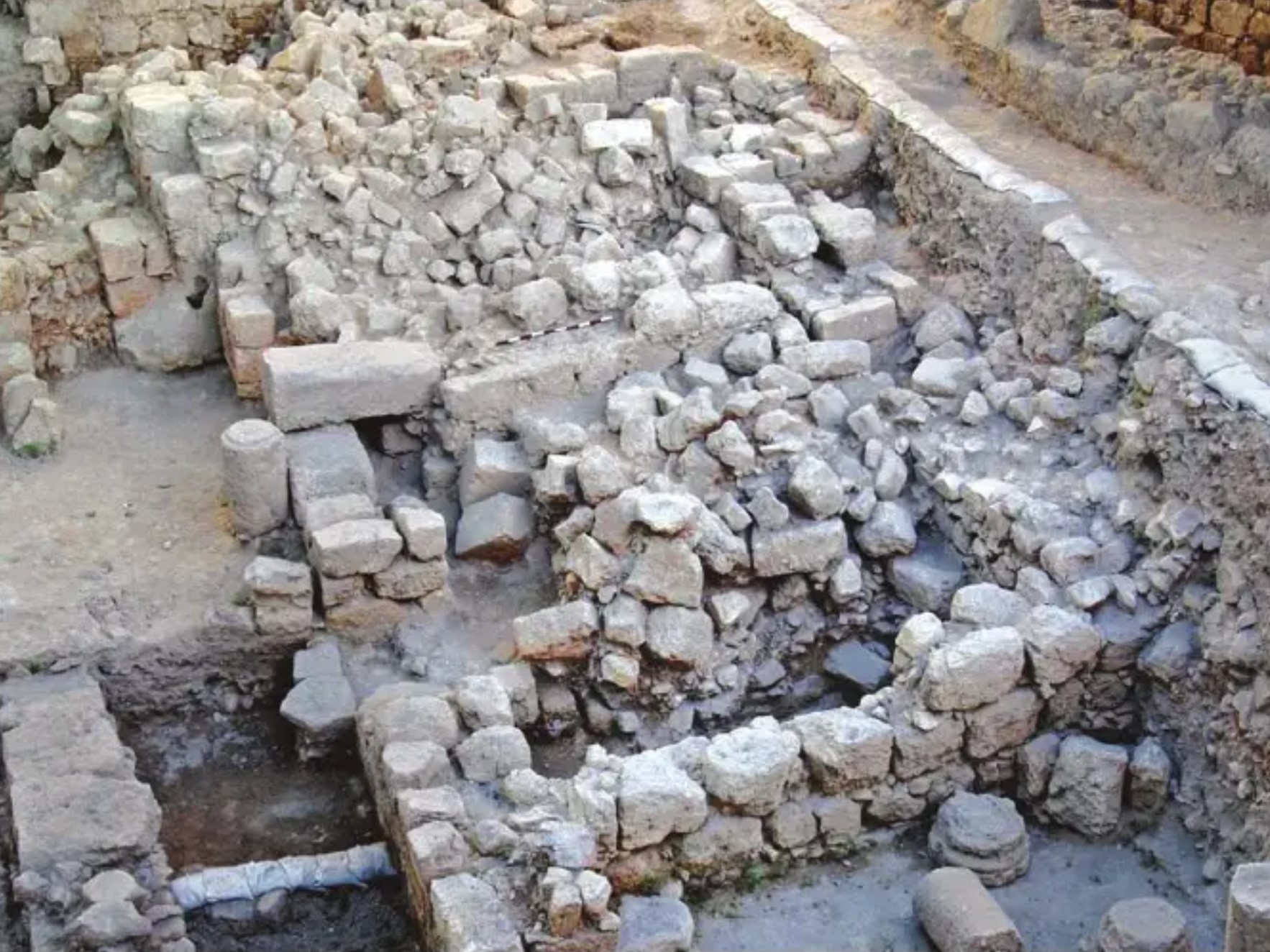Jerusalem - Givati Parking Lot
 The Givati Parking Lot Excavations, looking south
The Givati Parking Lot Excavations, looking southBen-Ami and Tchekhanovets (2019)
- from Chat GPT 5, 25 August 2025
- sources: Wikipedia – Givati Parking Lot dig, Wikipedia – City of David, City of David official site, Madain Project, Times of Israel (2025), The Media Line (2025), ArXiv (2025) muon imaging, Shalev et al. 2020
Excavations have exposed stratified remains spanning the Iron Age, Persian, Hellenistic, Roman, Byzantine, and Early Islamic periods. Work by the Israel Antiquities Authority and Tel Aviv University has revealed monumental architecture, domestic quarters, fortifications, luxury objects, and destruction layers. Shalev et al. (2020) note that the relocation of water from the Gihon Spring to the Siloam Pool shifted urban focus, and when post-586 BCE Jerusalem was rebuilt, that urban focus shited to the summit and northwestern slope.
Finds include a luxurious Iron Age residence destroyed in the 6th century BCE, Hellenistic walls and floors sealed by collapse, gold jewelry such as a 2,300-year-old ring with a gemstone, and a Roman-period figurine weight. In 2008, a hoard of 264 Byzantine gold coins dating to Emperor Heraclius was uncovered. Recent discoveries include a monumental Iron Age moat approximately 9 m deep and 30 m wide, redefining knowledge of Jerusalem’s northern defenses.
The site is also pioneering technological methods: in 2025 muon imaging was deployed to map subterranean voids and structural features. Today the Givati excavation remains a focal point for understanding the political, religious, and cultural evolution of Jerusalem across three millennia.
- from Jerusalem - Introduction - click link to open new tab
- Fig. 1 - Map of ancient
Jerusalem showing Givati Parking Lot Site from Shalev et al. (2020)
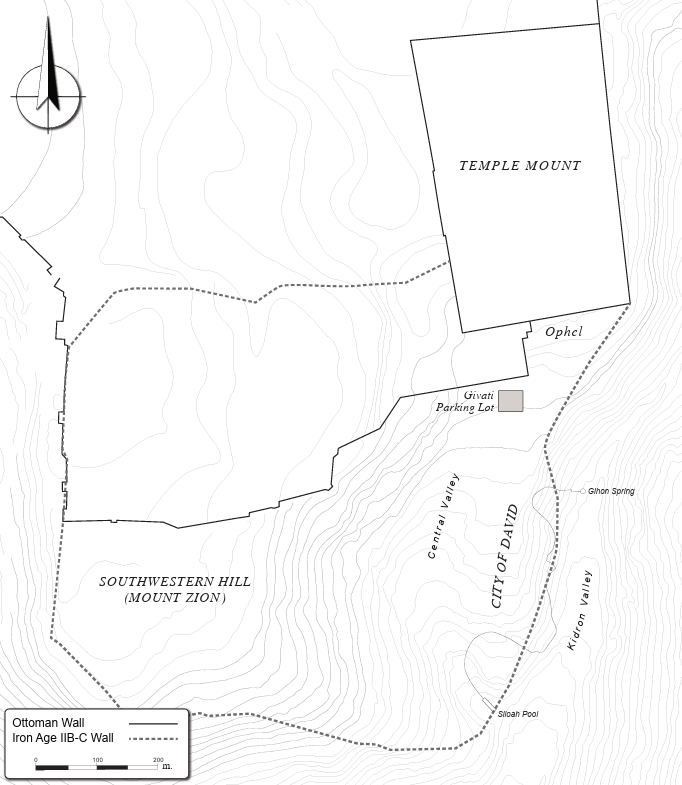
 Fig. 1
Fig. 1
Map of ancient Jerusalem marking the location of the Givati Parking Lot
Shalev et al. (2020)
- Fig. 2 - Map of Iron Age Jerusalem
from Finkelstein et. al. (2011)

 Fig. 2
Fig. 2
Map of Jerusalem showing the possible location of the supposed mound on the Temple Mount, the City of David and the line of the Iron IIB-C city-wall.
Finkelstein et. al. (2011) - Map of Jerusalem at the
end of the First Temple period from Stern et al (1993 v. 2)

 Map of Jerusalem at the end of the First Temple period
Map of Jerusalem at the end of the First Temple period
Stern et al (1993 v. 2) - Map of Jerusalem at the
end of the Second Temple period from Stern et al (1993 v. 2)

 Map of Jerusalem at the end of the Second Temple period
Map of Jerusalem at the end of the Second Temple period
Stern et al (1993 v. 2) - Map of Jerusalem in the
Roman period from Stern et al (1993 v. 2)

 Map of Jerusalem in the Roman period
Map of Jerusalem in the Roman period
Stern et al (1993 v. 2) - Map of Jerusalem in the
Byzantine period from Stern et al (1993 v. 2)

 Map of Jerusalem in the Byzantine period
Map of Jerusalem in the Byzantine period
Stern et al (1993 v. 2) - Map of Jerusalem in the
Early Arab period from Stern et al (1993 v. 2)

 Map of Jerusalem in the Early Arab period
Map of Jerusalem in the Early Arab period
Stern et al (1993 v. 2) - Map of Jerusalem in the
Crusader period from Stern et al (1993 v. 2)

 Map of Jerusalem in the Crusader period
Map of Jerusalem in the Crusader period
Stern et al (1993 v. 2)
- Fig. 2 - Map of Iron Age
Jerusalem from Finkelstein et. al. (2011)

 Fig. 2
Fig. 2
Map of Jerusalem showing the possible location of the supposed mound on the Temple Mount, the City of David and the line of the Iron IIB-C city-wall.
Finkelstein et. al. (2011) - Map of Jerusalem at the
end of the First Temple period from Stern et al (1993 v. 2)

 Map of Jerusalem at the end of the First Temple period
Map of Jerusalem at the end of the First Temple period
Stern et al (1993 v. 2) - Map of Jerusalem at the
end of the Second Temple period from Stern et al (1993 v. 2)

 Map of Jerusalem at the end of the Second Temple period
Map of Jerusalem at the end of the Second Temple period
Stern et al (1993 v. 2) - Map of Jerusalem in the
Roman period from Stern et al (1993 v. 2)

 Map of Jerusalem in the Roman period
Map of Jerusalem in the Roman period
Stern et al (1993 v. 2) - Map of Jerusalem in the
Byzantine period from Stern et al (1993 v. 2)

 Map of Jerusalem in the Byzantine period
Map of Jerusalem in the Byzantine period
Stern et al (1993 v. 2) - Map of Jerusalem in the
Early Arab period from Stern et al (1993 v. 2)

 Map of Jerusalem in the Early Arab period
Map of Jerusalem in the Early Arab period
Stern et al (1993 v. 2) - Map of Jerusalem in the
Crusader period from Stern et al (1993 v. 2)

 Map of Jerusalem in the Crusader period
Map of Jerusalem in the Crusader period
Stern et al (1993 v. 2)
- General plan of the peristyle
building from Ben-Ami and Tchekhanovets (2013)
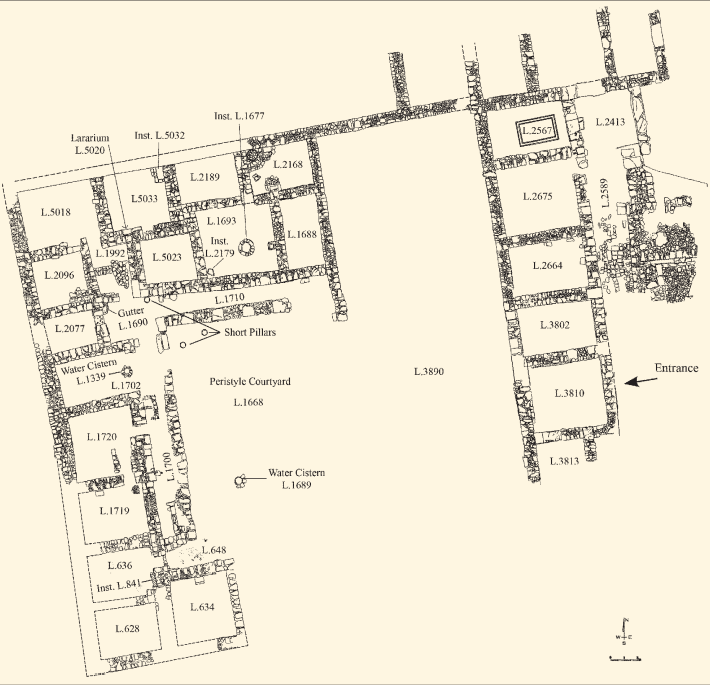
 Fig. 1
Fig. 1
General plan of the peristyle building
1980-89
Ben-Ami and Tchekhanovets (2013)
- General plan of the peristyle
building from Ben-Ami and Tchekhanovets (2013)

 Fig. 1
Fig. 1
General plan of the peristyle building
1980-89
Ben-Ami and Tchekhanovets (2013)
- Fig. 2 Aerial photo of the
Givati Parking Lot in 2018 from Shalev et al. (2020)
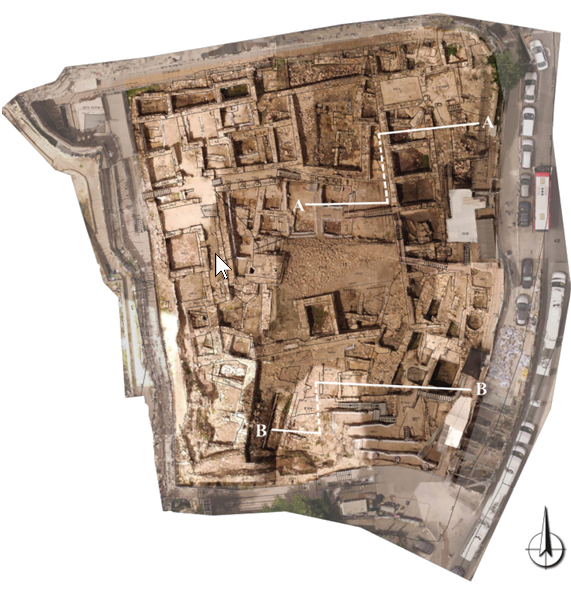
 Fig. 2
Fig. 2
Aerial photo of the Givati Parking Lot in 2018, showing all existing features at the site and the location of the sections shown in Fig. 5
(courtesy of City of David Archive, photo by Yair Izbozky).
Shalev et al. (2020) - Fig. 5a Section A-A
from Shalev et al. (2020)
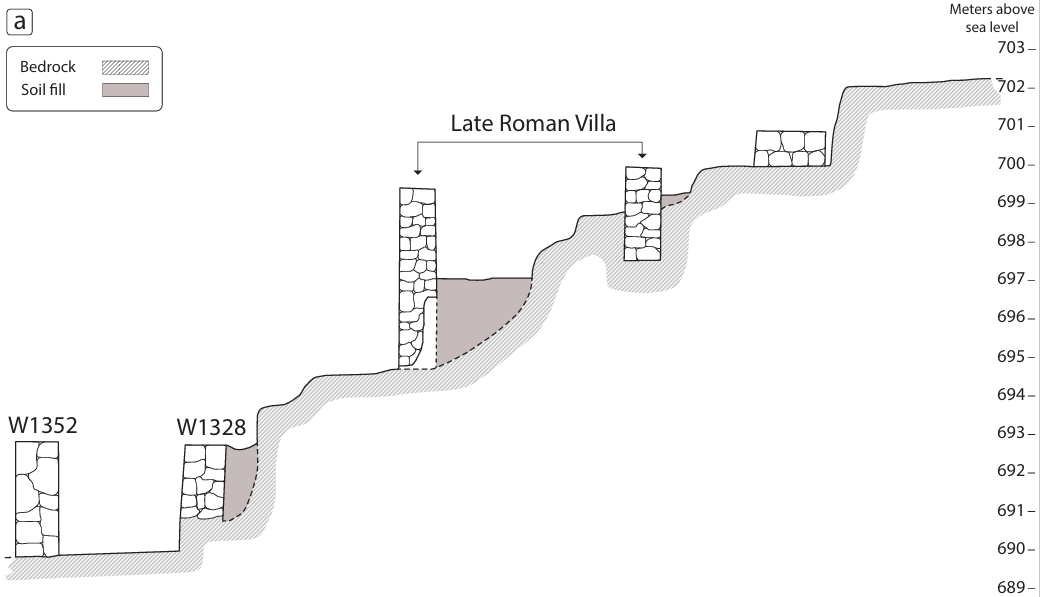
 Fig. 5a
Fig. 5a
Section A-A
Shalev et al. (2020) - Fig. 5b Section B-B
from Shalev et al. (2020)
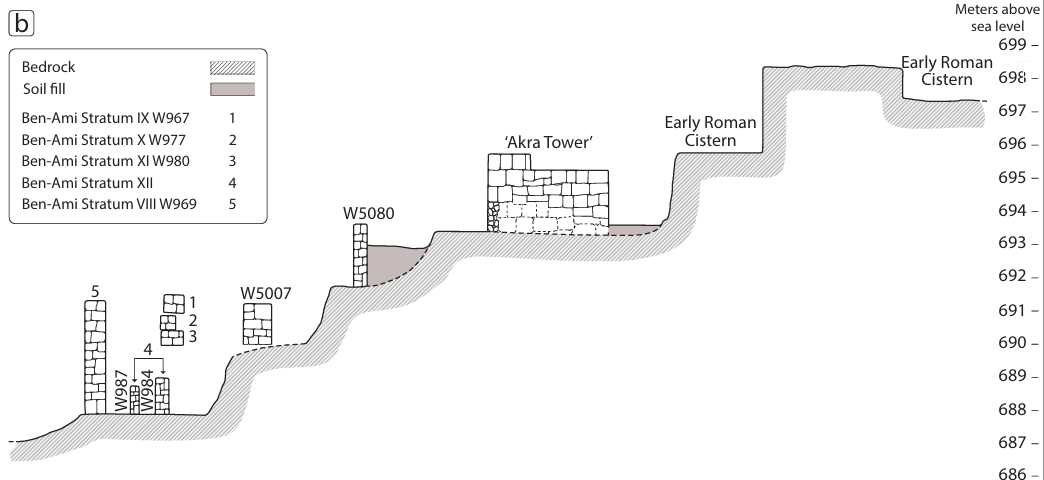
 Fig. 5b
Fig. 5b
Section B-B
Shalev et al. (2020)
- Fig. 2 Aerial photo of the
Givati Parking Lot in 2018 from Shalev et al. (2020)

 Fig. 2
Fig. 2
Aerial photo of the Givati Parking Lot in 2018, showing all existing features at the site and the location of the sections shown in Fig. 5
(courtesy of City of David Archive, photo by Yair Izbozky).
Shalev et al. (2020) - Fig. 5a Section A-A
from Shalev et al. (2020)

 Fig. 5a
Fig. 5a
Section A-A
Shalev et al. (2020) - Fig. 5b Section B-B
from Shalev et al. (2020)

 Fig. 5b
Fig. 5b
Section B-B
Shalev et al. (2020)
- 3D reconstruction of Jerusalem
with Givati site circled in yellow from BibleWalks.com

 Jerusalem Museum model of Herod’s Jerusalem – south side – area of excavations is marked in yellow
Jerusalem Museum model of Herod’s Jerusalem – south side – area of excavations is marked in yellow
Used with permission from BibleWalks.com
- 3D reconstruction of Jerusalem
with Givati site circled in yellow from BibleWalks.com

 Jerusalem Museum model of Herod’s Jerusalem – south side – area of excavations is marked in yellow
Jerusalem Museum model of Herod’s Jerusalem – south side – area of excavations is marked in yellow
Used with permission from BibleWalks.com
- Fig. 3 Collapse rubble in two rooms of the peristyle building from Ben-Ami and Tchekhanovets (2013)
- from Chat GPT 5, 25 August 2025
- from Shalev et al. (2020)
| Phase | Period | Date | Description |
|---|---|---|---|
| 10/IX | Iron IIC | Late 7th–early 6th c. BCE | Monumental building with Rooms A and B. Collapsed floors and smashed pottery vessels indicate destruction at the end of the Iron Age, likely linked to the Babylonian conquest of 586 BCE. Stone collapse preserved architectural elements such as windows and basins |
| 10/VIII | Persian | 6th–4th c. BCE | Rectangular chamber constructed into the ruins of Building 100. Ceramic assemblages characteristic of the Persian period, showing reuse and adaptation of earlier Iron Age structures. |
| 10/VIIa–b | Early Hellenistic (Seleucid) | 3rd–2nd c. BCE | Wall 1072 founded on the Iron Age collapse, with associated pier (1395). Floor 1051 sealed by a layer of collapsed stones. Pottery atop the floor dates the phase securely to the Early Hellenistic period:contentReference. |
| 10/VI–10/IV | Late Hellenistic | 2nd–1st c. BCE | Later building phases that incorporated, robbed, and modified earlier Hellenistic ashlar walls. Represents intensive reuse and architectural transformation on the western slope of the City of David ridge. |
| Stratum | Date | Name |
|---|---|---|
| IV | 9th century CE | The few stratified pottery assemblages from Stratum IV offer a chronological range for the beginning and end of activity of this occupation. Even though the dismantling of Installation 646 (Basket 5715) yielded wares dating to the transitional late Byzantine–Early Islamic period (sixth to eighth centuries; see Fig. 7.1:1–5), together with two fragments of what appear to be drain pipes (Fig. 7.1:6, 7), the fill underlying this structure (L665) contained much Abbasid pottery, typical of the ninth century.32 The contents within the installation (also L646; Figs. 7.2, 7.3) provide evidence of its latest use and the date of the overlying accumulation, datable to the ninth century.33 |
| III | 9th-10th century CE | Considering that Stratum IV can be dated to the mid-ninth century, Stratum III cannot have been abandoned earlier than the end of the ninth–early tenth centuries |
| II | 9th-10th century CE | Given the fact that Stratum III was apparently abandoned in the end of the ninth–early tenth centuries, and no typical wares of the eleventh century were detected, Stratum II should be dated to the early tenth century at the latest. |
| I | 9th-10th century CE | This stratum is characterized by a series of pits, without architectural context, containing mixed pottery, the latest consisting of wares typical of the ninth–tenth centuries, similar to those in the assemblages discussed above. The lack of eleventh-century wares implies that the area was abandoned during the tenth century. On the other hand, there were occasional fragments of thirteenth–fourteenth-century wares, as well as some Ottoman material, including Gaza Ware and glazed fragments, but mainly tobacco pipes |
32 The content of this fill resembles that of L672, with which it should be associated.
33 The 124 sherds recovered in the fill of Installation 646 (excluding Basket 5715 of the dismantling) also
included some earlier, Roman intrusions (11 sherds), and even anIron IIA burnished bowl fragment, all doubtless a
result of wash-out after the area was abandoned. However, the majority of the material is very homogeneous,
generally datable to the ninth–tenth centuries
Cytryn-Silverman (2013:167) described the unglazed and glazed wares
retrieved in the latest strata of occupation in Area M1
(Strata IV–I), associated with the Early Islamic period.
Cytryn-Silverman (2013:167) noted that the absence of relevant numismatic
evidence does not allow for refined chronological
nuances between the strata (apart from one coin of
Heraclius, all the datable coins recovered from the
loci presented here date to the late Hellenistic–Early
Roman periods; see Chapter 11).
Cytryn-Silverman (2013:180) discussed the potential significance of the site
The study of the Islamic pottery from Area M1 is potentially of considerable importance for the understanding of urban development in this part of Jerusalem under Islamic rule. The Giv‘ati Parking Lot site is located very close to the monumental complex of Umayyad buildings adjacent to the Temple Mount, and more specifically, almost immediately to the south of Building II, interpreted as the dār al-imāra (‘the government house’; for a summary of the finds from the Temple Mount excavations by B. Mazar and M. BenDov, see Ben-Dov 1982:293–321; Bahat 1996:70–73; Rosen-Ayalon 1996:393–395). It is also located within the perimeter of the fifth-century walls of Eudocia (Mazar 2007), but outside the alleged contracted course of the city walls (from at least the Fatimid period onward); thus, the pottery analysis is potentially informative for the process of the contraction of the city boundaries.
Due to the limited exposure of Early Islamic remains in Area M1 in the 2007 excavation season (most of the remains of Strata IV–I were excavated and removed during the 2003 season; see Chapter 1), few secure loci associated with this period were excavated. Therefore, a cautious approach is demanded when analyzing the ceramic finds. While the meager results from Area M1 do not shed any light on a relationship with the nearby Umayyad building complex, they may, however, assist in determining the chronology of the contraction of the city’s southern perimeter. The pottery provides a mid-ninth-century date as the terminus post quem for the erection of the building in Strata IV and III (see Fill 672 under Floor 664 for the earliest date for Stratum IV, and fills within Installation 646 and on Floor 667 for the earliest date for Stratum III), while the end of the ninth–early tenth centuries is the latest date for Stratum III. Stratum II should be dated to the early tenth century. The many pits in Stratum I filled with similar pottery assemblages indicate a general abandonment of the area during the tenth century. Could this abandonment have resulted from the area’s exclusion from the fortified city boundaries? Most of the historical discussions dealing with the contraction of the southern city wall have centered mainly on the description of the gates of Jerusalem written by al-Muqaddasī in 985 (Ahsan al-Taqasīm, 167; Best Divisions, 152–153).38 While Bahat proposed that the Jerusalemite geographer referred to an expanded city perimeter (encircled by Eudocia’s wall, which included Mt. Zion and the pool of Silwan; Bahat 1996:43–44), Tsafrir suggested a contracted city area, in which the new southern wall was erected over the old track of the Aelia Capitolina wall (Tsafrir 1977:155; see also Gil 1997:650–651, §847). Wightman also believed that alMuqaddasī described a contracted city, but in his view that process took place much earlier than suggested by Bahat and Tsafrir. If Bahat is correct, “the reduction in Jerusalem’s area took place sometime around the end of the tenth century [i.e., after al-Muqaddasī’s description; KCS] or the beginning of the eleventh [i.e., following the earthquake of 1033; KCS]… (Bahat 1996:44).39 Bahat also noted Vincent and Abel’s proposal that Eudocia’s wall was abandoned by orders of the Fatimid caliph al-‘Azīz (975–996 CE), in view of the raid by the Byzantine emperor Johannes Tzimikes in the environs of Jerusalem in 975 CE (Bahat 1996:43).40 If Tsafrir is correct, the fortified city area contracted even earlier, between 87041 and 966.42 Wightman, on the other hand, viewed the abandonment of Eudocia’s wall as a gradual process (Wightman 1993:235–236), beginning as early as the Umayyad period, and hastened toward its end, under Marwān II (r. 127/744–132/749–750).43
The pottery results unfortunately do not enable a clear-cut conclusion as to which wall al-Muqaddasī referred to. On the other hand, the presence of late ninth–early tenth-century wares underlying the building activity of Strata IV and III (supposedly built within the city limits) would seem to rule out Wightman’s interpretation (unless this was an extra-muros quarter, which would suit the concept of the rabad mentioned by al-Muqaddasī), and to undermine Tsafrir’s, as it allows little time for any major building activity to take place after the late ninth century and 966 CE. Still, the results hint that the city’s contraction happened before the end of the tenth century.44
The meager finds postdating the tenth century from Area M1—a few wares from the thirteenth–fourteenth centuries and the late seventeenth–eighteenth centuries—are testimony to the continuous exclusion of this area from the urban milieu.Footnotes38 Although al-Muqaddasī’s work was published at the end of the tenth century, his description of Jerusalem most probably refers to the middle of that century, when he still lived there (according to his biography, he was born in Jerusalem in 946 and left in 966). My thanks to Amikam Elad of the Dept. of Islamic and Middle Eastern Studies of The Hebrew University for elucidating this important detail on the chronological framework of al-Muqaddasī’s work.
39 Elsewhere, Bahat argued that Eudocia’s wall still existed in 1033 (Bahat 1996:57). This view has also been supported by Prawer, who proposed that the works were undertaken sometime between 1033 and 1063 (Prawer 1984:312). This dating, nevertheless, does not match the present archaeological results.
40 Vincent and Abel write: “Recouvrer les provinces orientales perdues par Héraclius, délivrer les Lieux saints, cette partie du programme de nicéphore Phocas faillit être remplie par son successeur Jean Zimiscès qui exécuta un raid audacieux en 975 jusqu›aux environs de Jérusalem, au moment où la domination fatimite était à peine assise dans ces contrées.
Cette vive alerte dut engager, pensons-nous [underline by KCS], le calife el-‘Aziz qui venait de succéder à Mou‘izz, à rendre plus forte la Ville sainte en abandonnant la ligne, trop développée au sud, du rempart d’Eudocia” (Vincent and Abel 1926:939–940).
Prawer (1984:312) strongly disagreed with Vincent and Abel’s view, by stressing that nicéphore Phocas never got close enough to Jerusalem to constitute a threat to the city. Prawer also believed that if such a great work had taken place around 968 CE, it would have been reflected in alMuqaddasī’s description. However, see n. 38 above, that 968 would have been after he left Jerusalem. The main flaw in Vincent and Abel’s proposition is its purely deductive nature, lacking any clear historical sources to corroborate it.
41 Bernard the Monk’s description of Jerusalem in 870 still refers to Jerusalem’s expanded boundaries (Tsafrir 1977:157–158; Bahat 1996:43).
42 The year 966 would, in fact, be too late if one assumes that if al-Muqaddasī had been an eye-witness to such an important event, it would be somehow reflected in his work. Therefore, the range 870–946 seems more plausible.
43 Wightman refers to both Marwān’s measures against cities that rebelled against his rule by destroying their fortifications, and to the earthquake of the mid-eighth century.
44 In should be noted, nevertheless, than in his recent doctoral dissertation, Omar Abed-Rabo claims for a clear post-1033 date for the contraction of the southern city wall, most probably during the 1060s (Abed-Rabo 2012:195–200). His dating, while convincing according to the historical evidence brought forward, is not endorsed by the current results. However, future research on the pottery from the other areas in the Giv‘ati Parking Lot may yield finds of the eleventh century and throw some new light onto this complex urban topic.
Ben-Ami and Tchekhanovets (2013) excavated a large peristyle building of the Late Roman period, located southwest of the Temple Mount in the Givati site of the City of David. Ben-Ami et al. (2013) dated its construction to the third century CE, based on a coin discovered in one of its walls. The coin, a provincial Roman issue from the reign of Diocletian, minted in Alexandria in 285 CE, provided a terminus post quem for the foundation of the building. The mansion later collapsed violently, burying scores of coins beneath the debris in various rooms. These coins date no later than 361 CE, supplying a terminus post quem for the destruction (Ben-Ami and Tchekhanovets 2013). They described the destruction as follows:
In the western wing, the floor of the living area collapsed, burying nearly all the remains of the ground floor. The surviving walls of the ground story, in some cases preserved to a height of over 3 m, were found under massive heaps of stones from the walls of the upper story. A large crack cuts through the stone slabs covering the underground water systems. These, along with other finds retrieved from the building, testify to the immense catastrophe it underwent. The ceramic assemblages found in the collapse and below it, on the floors of the building, are dated to the Late Roman–Early Byzantine period (third to fourth centuries CE). The dominant types are arched-rim basins and rouletted bowls.
The ‘Givʿati parking lot’ excavation site is located further south of the previously discussed Umayyad administrative buildings in the Ophel area (Fig. 10.1 no. 3). This is, except for the Haram al-Sharif area, the only place in Jerusalem which was drastically reconstructed at the beginning of the Umayyad period.19 This area was turned from what had been a prosperous Byzantine domestic quarter into an industrial quarter — mainly through the construction of a lime-kiln.20 This layout changed again “at some time during the eighth century CE” when, with the beginning of the Abbasid period, the lime-kiln was partly dismantled and covered, but only a few installations, wall stubs as well as pits were scattered throughout the area.21
In conclusion, one can say that at the site of the ‘Givʿati parking lot’ excavations noticeable changes occurred during the eighth century AD, but the causes cannot be determined with certainty. However, no archaeological traces of earthquake damage were observed at the site.22
19 Tchekhanovets 2018.
20 Ben-Ami 2020, 2–4.
21 Ben-Ami 2020, 283, 287 – pers. comm. Tchekhanovets.
22 Ben-Ami 2020, 283 – pers. comm. Tchekhanovets.
| Effect | Location | Image | Description |
|---|---|---|---|
|
floor of the living area in the western wing
 Fig. 1
Fig. 1General plan of the peristyle building 1980-89 Ben-Ami and Tchekhanovets (2013) |
|
-
Earthquake Archeological Effects chart
of Rodríguez-Pascua et al (2013: 221-224)

 Earthquake Archeological Effects (EAE)
Earthquake Archeological Effects (EAE)
Rodríguez-Pascua et al (2013: 221-224)
| Effect | Location | Image | Description | Intensity |
|---|---|---|---|---|
|
floor of the living area in the western wing
 Fig. 1
Fig. 1General plan of the peristyle building 1980-89 Ben-Ami and Tchekhanovets (2013) |
|
|
Ben-Ami, D. and Y. Tchekhanovets (2013). "A Roman Mansion Found in the City of David." Israel Exploration Journal 63(2): 164-173.
Ben-Ami, D. B., et al. (2013). "A Juridical Curse from a Roman Mansion in the City of David." Zeitschrift für Papyrologie und Epigraphik 186: 227-236.
Ben-Ami, D. and Tchekhanovets, Y. (2019). The Givati Excavations Project 2007-2015: From the Iron Age to the Early Islamic Period. in Jerusalem Revealed
Cytryn-Silverman, K (2013) "The Islamic-Period Pottery," in D. Ben-Ami (ed.), Excavations in the Tyropoeon Valley (Giv‘ati Parking Lot),
Final Report I: Area M1 (2007). (IAA Reports 52) Jerusalem, 2013, pp. 167–204.
Zimni-Gitler, J. (2025) Chapter 10. Traces of the AD 749 Earthquake in Jerusalem: New Archaeological Evidence from Mount Zion
, in Lichtenberger, A. and Raja, R. (2025) Jerash, the Decapolis, and the Earthquake of AD 749,
Brepolis
- download these files into Google Earth on your phone, tablet, or computer
- Google Earth download page
| kmz | Description | Reference |
|---|---|---|
| Right Click to download | Master Jerusalem kmz file | various |


